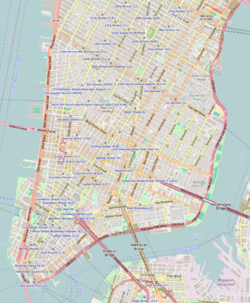Cast Iron House (361 Broadway) at the corner of Franklin Street and Broadway in the Tribeca neighborhood of Manhattan, New York City, formerly known as the James White Building, was built in 1881–82 and was designed by W. Wheeler Smith in the Italianate style.[2] It features a cast-iron facade, and is a good example of late cast-iron architecture.[3] The building was renovated by architect Joseph Pell Lombardi in 2000,[4] and a restoration of the facade began in 2009.[5] The building once housed the offices of Scientific American from 1884 to 1915,[6] but it was primarily used in connection with the textile trade.[3]
361 Broadway | |
New York City Landmark No. 1225
| |
 | |
| Location | 361 Broadway at Franklin Street, Manhattan, New York City |
|---|---|
| Coordinates | 40°43′3″N 74°0′14″W / 40.71750°N 74.00389°W |
| Built | 1881–1882 |
| Architect | W. Wheeler Smith (original) Shigeru Ban (renovation architect) |
| Architectural style | Italianate |
| NRHP reference No. | 83001718[1] |
| NYCL No. | 1225 |
| Significant dates | |
| Added to NRHP | September 15, 1983 |
| Designated NYCL | July 27, 1982 |
The building was designated a New York City landmark on July 27, 1982,[3] and was added to the National Register of Historic Places on September 15, 1983.
In 2014, Shigeru Ban Architects announced plans to convert the James White Building into a 13-unit luxury condominium building, known as the Cast Iron House.[7][8] A gut renovation was completed in 2021, with contemporary double-height living spaces inserted behind the restored cast-iron façade.[9] As part of the project, the existing floor slabs were removed, and the six-story structure was expanded to seven stories. A two-story penthouse structure, with two duplex apartments, was installed on the roof of 361 Broadway using a Vierendeel truss system.[10] To avoid adding stress to the historic façade, the independent structural system was devised to manage the additional load of the new penthouse floor using the existing foundation.
See also
editReferences
editNotes
- ^ "National Register Information System". National Register of Historic Places. National Park Service. March 13, 2009.
- ^ Norval White and Elliot Willensky, AIA Guide to New York City, rev. ed., (New York: Collier Books, 1978), p.40.
- ^ a b c Robins, Anthony W. "361 Broadway Designation Report" Archived September 20, 2021, at the Wayback Machine New York Landmarks Preservation Commission (July 27, 1982)
- ^ White, Norval & Willensky, Elliot (2000). AIA Guide to New York City (4th ed.). New York: Three Rivers Press. ISBN 978-0-8129-3107-5., p.75
- ^ "Projects: Commercial Buildings: 361 Broadway" on the Jan Hird Pokorny Associates website
- ^ Schlenoff, Dan (August 28, 2015). "Scientific American, on the Move". Scientific American Blog Network. Retrieved March 10, 2023.
- ^ Winston, Anna (April 23, 2014). "Shigeru Ban redesigns interiors for iron-clad New York apartment block". Dezeen. Retrieved October 20, 2022.
- ^ Pham, Diane (April 21, 2014). "Five Condos at the Shigeru Ban-Designed Cast Iron House Now Up for Sale". 6sqft. Retrieved October 20, 2022.
- ^ Hylton, Ondel (June 17, 2016). "Shigeru Ban's Cast Iron House Tops Out, Raises the Bar for Tribeca Penthouses". 6sqft. Retrieved October 20, 2022.
- ^ Viladas, Pilar (August 23, 2021). "Cast Iron House by Shigeru Ban Architects New York". Architectural Record. Retrieved October 20, 2022.
External links
edit


